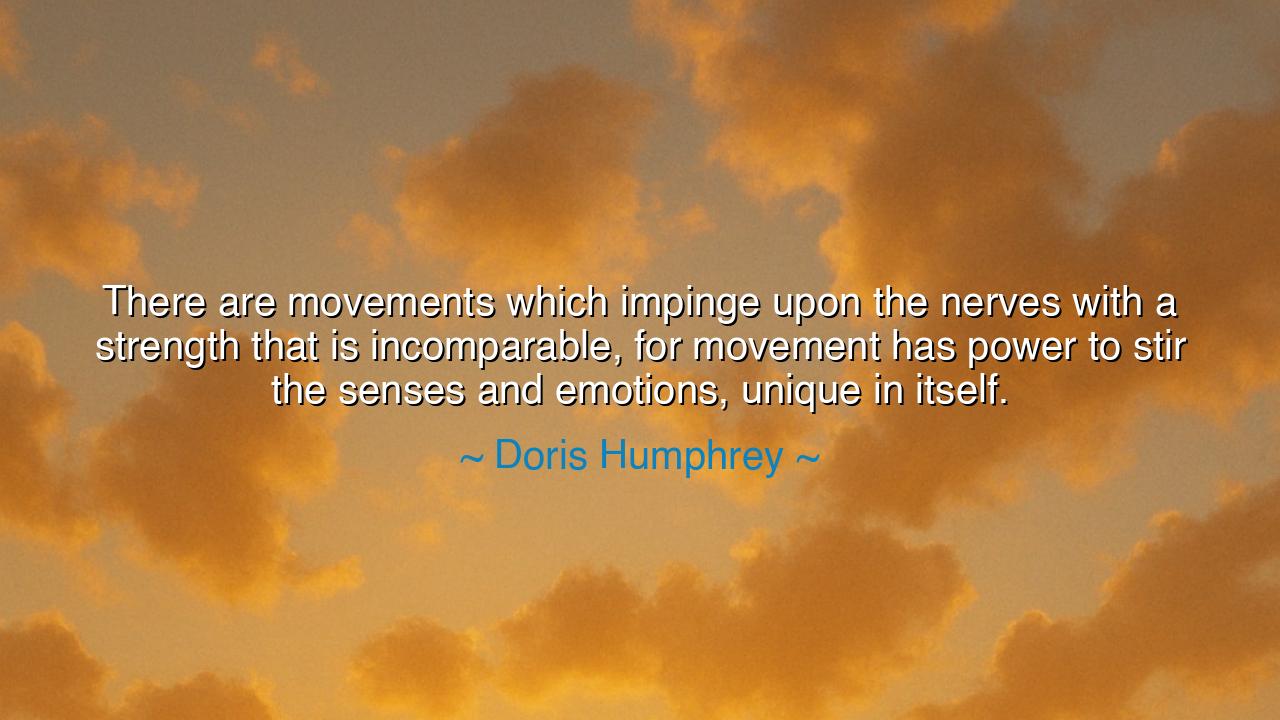
There are movements which impinge upon the nerves with a
There are movements which impinge upon the nerves with a strength that is incomparable, for movement has power to stir the senses and emotions, unique in itself.






"There are movements which impinge upon the nerves with a strength that is incomparable, for movement has power to stir the senses and emotions, unique in itself." Thus spoke Doris Humphrey, the pioneering choreographer and modern dancer, whose vision reshaped the world of artistic expression. In these words she reveals the eternal truth that the body, in motion, can speak a language deeper than words, touching not only the eyes but the very soul of those who witness it. For movement is not merely physical—it is spiritual, emotional, and elemental, carrying a power to awaken what lies hidden within the human heart.
The ancients knew this long before the stage was lit with modern lights. The dances of the Greeks were not idle entertainments but rituals, offerings to the gods, movements that called upon divine presence and stirred communal emotion. The warriors of old did not march to battle in silence—they stamped their feet, raised their shields, and moved as one, their movements igniting courage and trembling the nerves of their enemies. Such power is what Humphrey speaks of: that the body in motion carries messages beyond speech, evoking feelings that words cannot hold.
Consider the story of Martha Graham, a contemporary of Humphrey and another titan of modern dance. In her work, she used contraction and release—movements drawn from the very act of breath—to express grief, longing, and triumph. When audiences watched, they felt their own hidden emotions surface, stirred by the rawness of movement itself. The strength of such performances lay not in spectacle, but in their ability to awaken recognition within the human soul. Graham, like Humphrey, proved that movement can touch where language fails.
The power of movement is also evident in history beyond the arts. Think of Martin Luther King Jr. and the marchers who walked across Selma’s Edmund Pettus Bridge. Their steps were not choreographed for beauty, but their movement carried a message greater than any words. The sight of men and women, beaten yet still moving forward, impinged upon the nerves of a nation and stirred its conscience. Humphrey’s wisdom reminds us that all motion—whether in art, in ritual, or in protest—has the power to awaken the senses and move the heart.
Her words also remind us that the human body itself is a vessel of meaning. The way we walk, the way we gesture, the way we hold ourselves in joy or in sorrow—all these are movements that communicate without words. A bowed head speaks of humility. An outstretched hand offers peace. A clenched fist declares resistance. The emotions we feel take form in the motions we make, and in turn, those motions stir emotions in others. Thus, the cycle of expression and reception becomes a living dialogue written in the language of the body.
The lesson is profound: do not underestimate the power of your own movements. What you do with your body speaks to others as much as, if not more than, what you say. To move with kindness, to move with courage, to move with dignity—these are silent messages that resonate with incomparable strength. If you would inspire, let your actions align with your spirit; if you would comfort, let your gestures carry tenderness; if you would awaken, let your movements embody resolve.
Practically, this means cultivating awareness of the way you move through life. Walk with intention. Greet others with warmth in your gestures. Allow your body to express truth in harmony with your words. And when you feel deeply—joy, grief, love, or righteous anger—do not fear to let your movements embody what your voice cannot say. For in doing so, you connect with others at the level of the senses and the emotions, where words often falter but movement speaks eternal.
So let Humphrey’s teaching endure: “Movement has power to stir the senses and emotions, unique in itself.” Pass it down to dancers, to leaders, to every soul that moves upon this earth. For in the rhythm of steps, in the gestures of the body, in the silent eloquence of motion, lies a force that transcends speech—a force that binds hearts, awakens spirits, and stirs the world.






AAdministratorAdministrator
Welcome, honored guests. Please leave a comment, we will respond soon